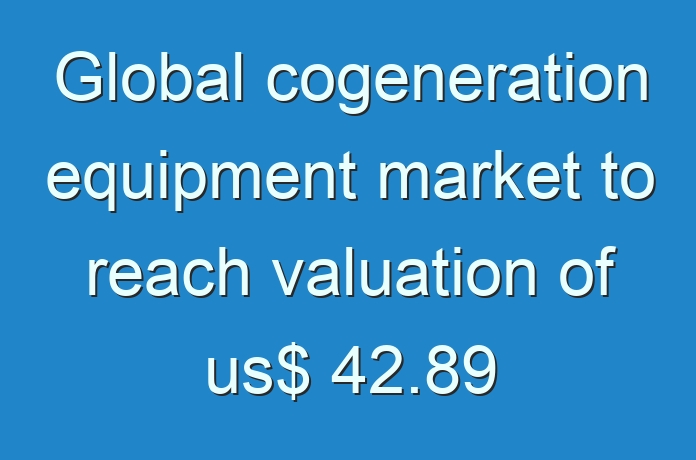
The global cogeneration equipment market is largely consolidated in nature, observes Transparency Market Research (TMR) in a new report. To further bolster their foothold, leading players in this market are forging alliances with original equipment manufacturers (OEMs) of various end-use industries. These companies are also investing in research to introduce innovative products, which will help them gain competitive advantage. They are also vying to tap growth opportunities in emerging economies, especially in Asia Pacific, which in turn will expand their geographical presence.
The global cogeneration equipment market was valued at US$ 20,245.9 Mn in 2018. Expanding at a CAGR of 9.84% during the forecast period from 2019 to 2027, the market is estimated to become worth US$ 42,896.4 Mn by the end of 2027.
On the basis of technology, gas turbine segment constituted major share in 2018. Application-wise, the industrial segment held more than 50% revenue share in the overall market in 2018. In terms of geography, Asia Pacific is expected to be the most lucrative region for global cogeneration equipment market during the forecast period
Request a Sample –
https://www.transparencymarketresearch.com/sample/sample.php?flag=S&rep_id=349
Depletion of Fossil Fuels Necessitating Sustainable Alternatives for Energy Generation Drives Growth
Globally, ever-increasing energy needs along with depletion of fossil fuels is necessitating the adoption of alternate techniques for energy generation such as cogeneration. Government initiatives for energy conservation and the need to tackle climatic changes have led to the adoption of cogeneration, which in turn is benefitting the cogeneration equipment market. Some of the cogeneration equipment are reciprocating engines, steam turbines, electric generators, boilers, heat recovery steam, and gas turbines.
Cogeneration or combined heat and power involves generation of heat and electricity simultaneously from a single fuel source such as biomass, natural gas, waste heat, wood, coal, or oil. Cogeneration is used across a host of areas such as shopping complexes, residential buildings, oil and gas production facilities, hospitals, universities, and small and large industries.
Apart from this, increasing fuel prices and unpredictable economic conditions across the world have created the pressing need for efficient power generation techniques to create sustainable and profitable energy solutions. Cogeneration is rapidly gaining popularity as it allows thermodynamically efficient use of oil at minimal energy wastage.
The increasing number of renewable energy projects in several parts of the world due to depletion of fossil fuels and the abundant availability of natural gas in several parts of the world such as Russia, the U.S., and Canada are stoking growth of cogeneration equipment market.
Buy now-
https://www.transparencymarketresearch.com/checkout.php?rep_id=349<ype=S
Need for Sophisticated Infrastructure Limits Adoption
Despite a number of favorable factors, the growth of cogeneration equipment market is hampered due to several factors. High initial investment along with need for sophisticated technological requirements for deployment of cogeneration equipment is challenging their adoption across small and medium-sized enterprises. Further, lack of adequate infrastructure leading to inconsistent orders is making difficult for product manufacturers to deal with plant management, cost depreciation, and inventory costs.
Competition Landscape
Key players in the global cogeneration equipment market include BDR Thermea, Siemens AG, Mitsubishi Heavy Industries Ltd., Clarke Energy, Innovate Steam Technologies, Foster Wheeler AG, ANDRITZ Energy & Environment GmbH, 2G Energy, ABB, Aegis Energy Services Inc., Rolls Royce Plc., Innovate Steam Technologies, and Kawasaki Heavy Industries.
The review presented is based on the findings of a TMR report, titled “Cogeneration Equipment Market (Capacity – Up to 30 MW, 31- 60 MW, and 61- 100 MW; Fuel – Biomass, Coal, and Natural Gas; Technology – Steam Turbine, Gas Turbine, Combined Cycle Gas Turbine, and Reciprocating Engine; Application – Industrial, Residential, and Commercial) – Global Industry Analysis, Size, Share, Growth, Trends, and Forecast 2019- 2027”
Request for covid19 impact analysis –
https://www.transparencymarketresearch.com/sample/sample.php?flag=covid19&rep_id=349
Key Development:
- In September 2019, German energy company Uniper SE has awarded a significant turnkey contract for a gas-fired, combined heat and power (CHP) plant in Scholven, Germany. Spanish engineering group SENER and German EPC contractor MMEC Mannesmann GmbH would supply two gas turbines and generator sets, two heat recovery steam generators, a steam turbine and generator set, and a direct-fired boiler.
- InApril 2018, US-based GE Power has been selected as the engineering procurement and commissioning (EPC) lead in a consortium with Alstom Power Systems to build the 1GW ultra-supercritical (USC) Ostroleka C coal energy plant in Poland.
The global cogeneration equipment market is segmented as follows:
Global Cogeneration equipment Market: By Capacity
- Upto 30 MW
- 31MW -60 MW
- 61 MW- 100 MW
Global Cogeneration equipment Market: By Fuel
- Biomass
- Coal
- Natural Gas
- Others
Global Cogeneration equipment Market: By Technology
- Steam Turbine
- Gas Turbine
- Combined Cycle Gas Turbine
- Reciprocating engine
- Others
Global Cogeneration equipment Market: By Application
- Industrial
- Residential
- Commercial
Global Cogeneration equipment Market: By Region
- North America
- US
- Canada
- Europe
- Germany
- UK
- France
- Italy
- Spain
- Rest of Europe
- Asia Pacific
- China
- India
- Japan
- ASEAN
- Rest of Asia Pacific
- Middle East
- GCC
- Egypt
- Rest of Middle East
- Africa
- South Africa
- Nigeria
- Rest of Africa
- Latin America
- Brazil
- Mexico
- Rest of Latin America
More Trending Report-





